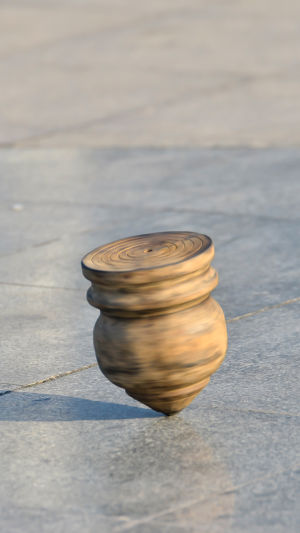There are three kinds of gyroscopes: wooden gyroscope, chemical plastic gyroscope and iron gyro.
1. Iron gyro:
The iron top is quite special.
From the top, it is less than three and a half centimeters wide, like a depression in the middle of a six-petal flower.
It is triangular cone-shaped, flat at the top, pointed at the bottom, and about one centimeter high from the side.
2. Wooden top:
It is appropriate to find hardwood to do, the hardest is the pomegranate trunk, followed by longan wood, Jiuxiong wood and camphor wood, the others are poor.
3. Plastic gyro:
There is a kind of gyroscope specially made for listening to sound, with hollow holes in the body and handles up and down.
The upper handle can be used to twist the rope, and once it rotates, the hole of the body will make a whining sound.
In order to make it spin faster and make a louder sound, it is often tied to a small piece of wood at the end of the rope.
After wrapping the rope, it is pressed against the top with a piece of wood in one hand, and the rope is drawn from the hole in the chip in the other, so that the top will fly around and make a loud sound.
The principle of gyro rotation is that the gyro "rotates" around its axis on one side and "precession" around the vertical axis on the other.
In other words, the gyroscope does not stand vertically above the ground, but deviates from the normal of the ground and tilts to the ground.
Therefore, the moment of gravity on the gyro is not zero, and the precession angular momentum of the gyro can balance the action of the gravity moment.
So the gyro will not fall to the ground when it rotates.
The inertia ellipsoid of the rigid body to the fulcrum is called the rotating ellipsoid.
The moment of inertia of the rigid body to the symmetric axis is called the polar moment of inertia.
The moment of inertia of the rigid body to the principal axis of inertia of the other two passing through the fulcrum (see inertia tensor) is called the equatorial moment of inertia.
The gyro is a rigid body moving around the fulcrum, so the kinematic and dynamic equations of the fixed-point motion of the rigid body are applicable to the gyro.
When the gyro rotates to the end, there are three possibilities, which are related to the density, weight, material, bottom structure and ground material of the gyro itself.
1. The gyro is still stable after stall, and finally the gyro does not fall to the ground, the friction work consumes the gyro kinetic energy, and the gyro stops.
The reason for this is that the bottom of the gyroscope is flat, the structure of the gyroscope is symmetrical and the center of gravity is low and stable.
2. After stall, the gyro becomes unstable and begins to tilt.
After one side falls to the ground, it rotates in the original direction and finally stops.
3. After stall, the gyro becomes unstable and begins to tilt.
After one side falls to the ground, it rolls in the original direction, then suddenly rolls in the opposite direction, and finally stops (several repeated reversals may occur before stopping).
This kind of gyroscope is generally small, generally made of wood or plastic, rubber (it is proved that non-high-strength iron is also OK), and has no spikes.





